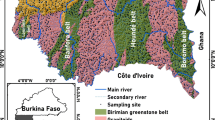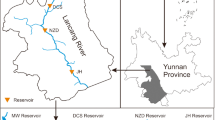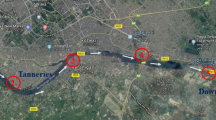Abstract
Streams and rivers strongly affected by acid mine drainage (AMD) have legal vacuum in terms of assessing the water toxicity, since the use of conventional environmental quality biomarkers is not possible due to the absence of macroinvertebrate organisms. The Asian clam Corbicula fluminea has been widely used as a biomonitor of metal contamination by AMD in freshwater systems. However, these clams are considered an invasive species in Spain and the transplantation in the field study is not allowed by the Environmental Protection Agency. To evaluate the use of the freshwater bivalve C. fluminea as a potential biomonitor for sediments contaminated by AMD, the metal bioavailability and toxicity were investigated in laboratory by exposure of clams to polluted sediments for 14 days. The studied sediments were classified as slightly contaminated with As, Cr, and Ni; moderately contaminated with Co; considerably contaminated with Pb; and heavily contaminated with Cd, Zn, and specially Cu, being reported as very toxic to Microtox. On the fourth day of the exposure, the clams exhibited an increase in concentration of Ga, Ba, Sb, and Bi (more than 100 %), followed by Co, Ni, and Pb (more than 60 %). After the fourth day, a decrease in concentration was observed for almost all metals studied except Ni. An allometric function was used to determine the relationship between the increases in metal concentration in soft tissue and the increasing bioavailable metal concentrations in sediments.





Similar content being viewed by others
References
Andrés S, Baudrimont M, Lapaquellerie Y, Ribeyre F, Maillet N, Latouche C, Boudou A (1999) Field transplantation of the freshwater bivalve Corbicula fluminea along a polymetallic contamination gradient (River Lot, France): I. Geochemical characteristics of the sampling sites and cadmium and zinc bioaccumulation kinetics. Environ Toxicol Chem 18:2462–2471
Arini A, Daffe G, Gonzalez P, Feurtet-Mazel A, Baudrimont M (2014) Detoxification and recovery capacities of Corbicula fluminea after an industrial metal contamination (Cd and Zn): a one-year depuration experiment. Environ Pollut 192:74–82
Audry S, Blanc G, Schafer J (2005) The impact of sulphide oxidation on dissolved metal (Cd, Zn, Cu, Cr, Co, Ni, U) inputs into the Lot–Garonne fluvial system (France). Appl Geochem 20:919–931
AZUR (1998)Environmental Microtox M500 Manual. Carlsbad
Barfield ML, Farris JL, Black MC (2001) Biomarker and bioaccumulation responses of Asian clams exposed to aqueous cadmium. J Tox Env Health A 63:495–510
Bilos C, Colombo JC, Skorupka CN, Demichelis SO, Tatone LM (2009) Size-related trace metal bioaccumulation in Asiatic clams (Corbicula fluminea) from the Rio de la Plata estuary, Argentina. Int J Environment and Health 3:390–409
Bonnail E, Sarmiento AM, DelValls TA, Nieto JM, Riba I (2016) Assessment of metal contamination, biavailability, toxicity and bioaccumulation in extreme metallic environments (Iberian Pyrite Belt) using Corbicula fluminea. Sci Total Environ 544:1031–1044
Brouwer H, Murphy T, McArdle L (1990) A sediment contact bioassay with Photobacterium phosphoreum. Environ Toxicol Chem 9:1353–1358
Campisi T, Abbondanzi F, Casado-Martínez C, DelValls TA, Guerra R, Iacondini A (2005) Effect of sediment turbidity and color on light output measurement for Microtox® Basic Solid-Phase Test. Chemosphere 60:9–15
Caraballo MA, Sarmiento AM, Sánchez-Rodas D, Nieto JM, Parviainen A (2011) Seasonal variations in the formation of Al and Si rich Fe-stromatolites in the highly polluted acid mine drainage of Agua Agria Creek (Tharsis, SW Spain). Chem Geol 284:97–104
Chalkiadakiab O, Dassenakisb M, Lydakis-Simantirisa N (2014) Bioconcentration of Cd and Ni in various tissues of two marine bivalves living in different habitats and exposed to heavily polluted seawater. Chem Ecol 30:726–742
Chen WY, Liao CM (2012) Toxicokinetics/toxicodynamics links bioavailability for assessing arsenic uptake and toxicity in three aquaculture species. Environ Sci Pollut R 19:3868–3878
Doherty FG, Cherry DS (1988) Tolerance of the Asiatic clam Corbicula spp. to lethal levels of toxic stressors—a review. Environ Pollut 51:269–313
Fletcher DE, Lindell AH, Stillings GK, Mills GL, Blas SA, Vaun McArthur J (2014) Spatial and taxonomic variation in trace element bioaccumulation in two herbivores from a coal combustion waste contaminated stream. Ecotox Environ Safe 101:196–204
Förstner U (1985) Chemical methods for assessing bio-available metals in sludges and soils. Elsevier Applied Science Publishers
Håkanson L (1980) An ecological risk index for aquatic pollution control. A sedimentological approach. Water Res 14:975–1001
Hedouin L, Pringault O, Bustamante P, Fichez R, Warnau M (2011) Validation of two tropical marine bivalves as bioindicators of mining contamination in the New Caledonia lagoon: field transplantation experiments. Water Res 45:483–496
Hedouin L, Pringault O, Metian M, Bustamante P, Warnau M (2007) Nickel bioaccumulation in bivalves from the New Caledonia lagoon: seawater and food exposure. Chemosphere 66:1449–1457
Luoma SN (1989) Can we determine the biological availability of sediment bound to trace elements? Hydrobiologia:379–396
Nieto JM, Sarmiento AM, Cánovas CR, Olías M, Ayora C (2013) Acid mine drainage in the Iberian Pyrite Belt: 1. Hydrochemical characteristics and pollutant load of the Tinto and Odiel rivers. Environ Sci Pollut Res 20(11):7509–7519
Nieto JM, Sarmiento AM, Olías M, Cánovas CR, Riba I, Kalman J, Delvalls TA (2007) Acid mine drainage pollution in the Tinto and Odiel rivers (Iberian Pyrite Belt, SW Spain) and bioavailability of the transported metals to the Huelva Estuary. Environ Int 33:445–455
Nocete F, Saez R, Nieto JM, Cruz-Aunon R, Cabrero R, Alex E, Bayona MR (2005) Circulation of silicified oolitic limestone blades in South-Iberia (Spain and Portugal) during the third millennium B.C.: an expression of a core/periphery framework. J Anthropol Archaeol 24:62–81
Peltier GL, Wright MS, Hopkins WA, Meyer JL (2009) Accumulation of trace elements and growth responses in Corbicula fluminea downstream of a coal-fired power plant. Ecotox Environ Safe 72:1384–1391
Porter CM, Nairn RW (2010) Fluidized bed ash and passive treatment reduce the adverse effects of acid mine drainage on aquatic organisms. Sci Total Environ 408:5445–5451
Rauret G, López-Sánchez JF, Sahuquillo A, Rubio R, Davidson CI, Ure A, Quevauviller P (1999) Improvement of the BCR three step sequential extraction procedure prior to the certification of new sediment and soil reference materials. J Environ Monitor 1:54–61
Reis PA, Guilhermino L, Antunes C, Sousa R (2014) Assessment of the ecological quality of the Minho estuary (Northwest Iberian Peninsula) based on metal concentrations in sediments and in Corbicula fluminea. Limnetica 33(1):161–174
Riba I, DelValls TA, Forja JM, Gómez-Parra A (2002) Influence of the Aznalcóllar mining spill on the vertical distribution of heavy metals in sediments from the Guadalquivir estuary (SW Spain). Mar Pollut Bull 44:39–47
Sarmiento AM, Nieto JM, Casiot C, Elbaz-Poulichet F, Egal M (2009b) Inorganic arsenic speciation at river basin scale: the Tinto and Odiel Rivers in the Iberian Pyrite Belt, SW Spain. Environ Pollut 157:1202–1209
Sarmiento AM, Nieto JM, Olías M, Cánovas CR (2009a) Hydrochemical characteristics and seasonal influence on the pollution by acid mine drainage in the Odiel river basin (SW Spain). Appl Geochem 24:697–714
Sarmiento AM, Olías M, Nieto JM, Cánovas CR, Delgado J (2009c) Natural attenuation processes in two water reservoirs receiving acid mine drainage. Sci Total Environ 407:2051–2062
Sarmiento AM, DelValls TA, Nieto JM, Salamanca MJ, Caraballo M (2011) Toxicity and potential risk assessment of a river polluted by acid mine drainage in the Iberian Pyrite Belt (SW Spain). Sci Total Environ 409:4763–4771
Soucek DJ, Cherry DS, Currie RJ, Latimer HA, Trent GC (2000) Laboratory to field validation in an integrative assessment of an acid mine drainage–impacted watershed. Environ Toxicol Chem 19:1036–1043
Tessier A, Campbell PGC, Bisson M (1979) Sequential extraction for the speciation of particulate trace metals. Anal Chem 51:844–851
Vives A, Brienza S, Moreira S, Zucchi O, Barroso R, Filho V (2007) Evaluation of the availability of heavy metals in lake sediments using SR-TXRF. Nucl Instrum Met A 579:503–506
Zaroogian GE, Johnson M (1984) Nickel uptake and loss in the bivalves Crassostrea virginica and Mytilus edulis. Arch Environ Con Tox 13:411–418
Zhao L, Yang F, Yan X, Huo Z, Zhang G (2012) Heavy metal concentrations in surface sediments and manila clams (Ruditapes philippinarum) from the Dalian Coast, China after the Dalian port oil spill. Biol Trace Elem Res 149:241–247
Zuykov M, Pelletier E, Harpen DAT (2013) Bivalve mollusks in metal pollution studies: from bioaccumulation to biomonitoring. Chemosphere 93:201–208
Acknowledgments
AM Sarmiento was financially supported by the postdoctoral position within the “Programa de Fortalecimiento de las Capacidades en I+D+I” of the University of Huelva. E Bonnail thanks the International Grant from Bank Santander/UNESCO Chair UNITWIN/WiCop and the Erasmus Mundus Programme for the MACOMA Doctoral funding contract (SGA 2012-1701/001-001 EMJD). We also thank the reviewers for their valuable comments.
Author information
Authors and Affiliations
Corresponding author
Additional information
Responsible editor: Philippe Garrigues
Rights and permissions
About this article
Cite this article
Sarmiento, A.M., Bonnail, E., Nieto, J.M. et al. Bioavailability and toxicity of metals from a contaminated sediment by acid mine drainage: linking exposure–response relationships of the freshwater bivalve Corbicula fluminea to contaminated sediment. Environ Sci Pollut Res 23, 22957–22967 (2016). https://doi.org/10.1007/s11356-016-7464-9
Received:
Accepted:
Published:
Issue Date:
DOI: https://doi.org/10.1007/s11356-016-7464-9




